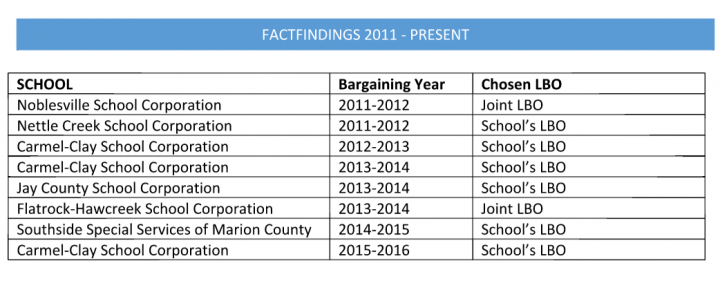
By Ann Marie Shambaugh
For the third time in four years, Carmel Clay Schools and the union representing its teachers could not work out a contract deal on their own, and for the third time in as many years a state appointed Factfinder has selected the district’s offer as the collective bargaining agreement moving forward.
“It is the conclusion of the Factfinder that the (Carmel Clay Educators Association) Proposal does not serve the interests of Carmel Clay students and is inconsistent with applicable law,” states the Factfinder’s report.
The two parties had reached a tentative agreement that would have given teachers a 2 percent raise across the board, but CCEA, which represents the teachers, did not ratify it.
This led to both sides submitting Last Best Offers at a fact finding hearing on Dec. 11, and by the end of the month the factfinder named the district’s proposal as the new collective bargaining agreement for the 2015-2016 school year. CCEA has 30 days to file an appeal.
CCEA president Brian Lyday said he did not yet know if the teachers would appeal the decision. The union did appeal the previous two rulings to no avail.
The district’s Last Best Offer included a .5 percent pay raise for teachers. The raise dropped from 2 percent offered in the Tentative Agreement because state law requires that districts not go into deficit financing once discussions reach this level. The district planned to use its cash balances to help pay for the 2 percent pay increases in the Tentative Agreement but was prohibited from using these funds once the process reached the factfinding stage.
“The teachers’ failure to ratify the (Tentative Agreement) caused them to lose out on their opportunity to share in the (Carmel Clay School Corporation)’s anticipated 2 percent salary increase because following a declaration of impasse the CCSC is no longer permitted to spend funds on hand,” the factfinder report states.
“To comply with that law and avoid unlawful deficit financing, the school district had to reduce the amount it offered during bargaining by approximately $835,000,” said Hudnall Pfeiffer, an attorney for the district, adding that it equated to about $902 less pay per teacher than the tentative agreement offered, at school board meeting Jan. 11.
Lyday said that because the district is receiving about 5 percent more in revenues for the 2015-2016 school year, expenses – including teacher pay – should also go up about 5 percent. Instead, teachers with the most experience are only getting a .75 percent raise from last year because a one-time stipend they received in 2014-2015 was not included in the equation.
“Here you have teachers who have been committed to the district 18 years or more who are getting the least of anyone,” Lyday said.
Additional benefits included in the district’s Last Best Offer are “insurance holidays” allowing teachers to avoid paying insurance premiums twice a year, eliminating a requirement to use certain mail order prescriptions, an additional paid day of bereavement leave for necessary travel and more.
Since the factfinding process became an option in 2011, Carmel is the only school district to have gone through the process more than one time. It was the only district to reach the factfinding stage so far for the 2015-2016 school year.
In the eight cases that have been decided by a factfinder, school district proposals have been selected six times, with the other two resulting in joint offer combining elements from both sides.



